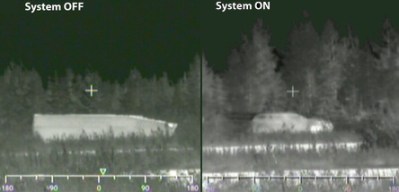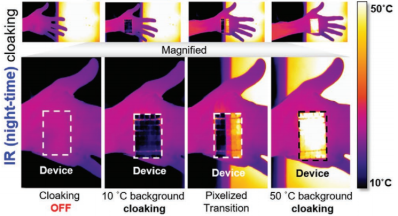An invisibility cloak may seem like science fiction, but despite that, many scientists and engineers have put much time into developing the concept, pushing it closer to reality. A device which detects the nature of its surroundings and changes its own properties to blend in may be complex, but a multitude of examples in the animal world show that it’s not impossible to achieve.
A team from Seoul National University recently developed a flexible material designed in part as a flexible “cloaking” material. We’ll take a look at the underlying concept behind such devices below, and look at how this work furthers the state of the art in the field.
Hiding in Plain Sight
Many cloaking devices have been theorized over the years. Much investigation has been done into advanced metamaterials that are able to interact with varying wavelengths of light, and through some very advanced physics, hide objects from view. So far, these devices largely remain on paper only, with a few experiments able to effectively “cloak” objects from precise wavelengths and certain vantage points. At our current level of technology, more practical efforts focus on what is known as active camouflage. This is more akin to the way animals like squid and chameleons alter their appearance to match their surroundings. Active camouflage is a two-part process; first, the surroundings must be perceived, and secondly, the object to be hidden must change its appearance to match.

The simplest concept of active camouflage is to cover an object, person, or vehicle in screens. By using cameras to image the surrounding area, the screens can be used to display what is on the other side of the object to an observer, effectively hiding the object from view. However, many challenges have thus far prevented its practical use. Accurately capturing an object’s surroundings can be achieved with cameras, but a full 360 degree view is required in order to properly hide an object from all directions. This can require an impractical number of cameras to achieve. Additionally, resolution limitations and lens distortions serve to further reduce the viability of such methods. Furthermore, current display technologies are often heavy and consume significant amounts of power. Any lag in the transmission of image from camera to screen can also spoil the effect when the object or its surroundings are moving.
A test by Top Gear in 2012 did a great job of showing the limitations of this method, with a Ford Transit decked out with cameras and mostly covered in screens. The final effect achieved was one of mild camouflage at significant distance, but virtually useless at close to medium range. The rig also had huge power requirements, needing a diesel generator to supply enough current to run the many screens.
Camouflage, So Hot Right Now

Similar efforts have been made in the realm of thermal camouflage, intended to hide military vehicles from sensors in the infrared spectrum. BAE Systems developed ADAPTIV, a system consisting of hexagonal tiles installed on the outside of a military vehicle. Each tile contains a Peltier element, enabling it to be heated or cooled as required. The tiles can be controlled to either match the temperature of the vehicle’s surroundings, or to mimic the thermal signature of an innocuous vehicle or object. The technology could prove useful to hide vehicles from observers with thermal imaging gear, and potentially even help reduce the likelihood of a successful hit from a heat-seeking warhead.
As of 2020, there has been no confirmation that such technology has seen use in the field. The possibility exists that it could be used in top secret covert operations, akin to the stealthy Black Hawk employed by the US military. However, the system does have a major flaw — the heat generated by the host vehicle still has to go somewhere. While externally-applied panels may help hide the vehicle’s thermal signature from some aspects or vantage points, exhaust plumes or simply warming the surroundings could be a dead giveaway. The system also does nothing to protect against other forms of detection, like radar.
Camouflage Skin Shows a Proof of Concept, But Still Science Fiction

The recent South Korean designed “artificial skin”, described in a scientific paper, is interesting for two reasons. Firstly, it aims to work on the human scale, rather than for vehicles or larger objects. Secondly, it has two functional modes; a thermal camouflage mode, and a visual camouflage mode. In the thermal mode, a grid of “pixels”, each consisting of a Peltier element, can change temperature to mimic the thermal signature of the background. Alternatively, it can be used for visual camouflage, as each pixel is also coated with thermochromic crystals that change colour depending on temperature. When below a certain temperature, the pixels are black, but as they heat up, they change from red to green to blue. One limitation is that the device can only perform one type of camouflage (thermal or visual) at a time, not both at once because the visual signature is dependent on the temperature of the pixels.

Unfortunately, the artificial skin is not yet a practical camouflage device. The basic operation of the Peltier elements and thermochromic coating in a flexible form factor have proved workable. However, the panels produced thus far have been of a small size, and feature no ability to sense their surroundings. Instead, they have been manually controlled to match their surroundings in a laboratory environment. Experiments are ongoing with small cameras, however, mapping a two-dimensional image onto a moving, flexible sheet will pose challenges.
While practical devices don’t yet exist, the world of active camouflage promises to grow more interesting as new display, material, and detection technologies come to the fore. At our current level of sophistication, crude designs have been achieved, with little practical application thus far. It’s likely that we’ll need to see advances in several other base technologies before active camouflage becomes mainstream, akin to the way the lithium polymer battery and advanced microelectronics enabled the creation of the quadcopter drone. Until then, dreams of invisibility will remain just that!
No comments:
Post a Comment